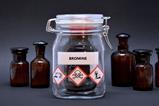Stability data is necessary but tedious work

In my family, I am the person who cleans out the refrigerator on a regular basis. I will get down on my hands and knees, wipe out the crumbs, discard the old bags of green onions that have begun to rot and throw away the floppy broccoli that seems to regularly accumulate in our produce drawer.
And then there is the door of my refrigerator, where the various condiments lie. Is this pickle relish any good anymore? I don’t really know, and sometimes I don’t care to find out. However, one of my children has a really excellent nose so I’ll sometimes ask them if the cheese spread has gone off into the land of microbiological experiments and needs to be tossed.
When it’s chemicals and not food, you don’t have to rely on your nose. Rather, you have specifications that you can test against. If it’s a simple compound or reagent, this is straightforward. Don’t know if that ethyl magnesium chloride is any good because it’s three years old? Get some plant operators to take a sample, get the sample to your favourite quality control chemist and get them to test it. If it still meets spec, that’s a great sign. (If it doesn’t, it’s time to send that material to the hazardous waste facility.) If it’s a more complex material or it’s needed for a crucial step, you might want to run a use test (ie use it in the subsequent synthetic step) and test that product as well.
What I appreciate about the commercial chemical manufacturing world is that it’s not the food-related term ‘expiration date’, but rather a ‘retest date’. In other words, the question is not ‘when will this material not be the material?’ Rather, it’s a question about ‘when should you check this material again to see if it is good?’ To my chemist ears, that makes a lot more sense.
United States law requires pharmaceutical companies to determine the appropriate length of time that a drug will meet standards of ‘strength, quality and purity at the time of use’. It also requires that the testing be done in the same packaging that the drug is sold in. So how do we determine how long medicines are good for?
I learned about this first-hand decades ago, in my first job out of college. I was working in a drug development laboratory, where the company was developing a system to deliver drug compounds through a new type of tablet coating. We needed to learn about the stability of these coatings and the stability of the drugs inside the coated tablets.
Press on
Making the mixture to go into tablets was like the beginning stages of baking, where you’re combining a series of powders. Of course, there was the actual drug molecule (the active pharmaceutical ingredient, or API), and there were also the various excipients – the other compounds that go into a pill or a tablet that aren’t the API. (My favourite to learn about was magnesium stearate, which is added to lubricate the flow of the powder through the tableting presses.)
I didn’t expect to be literally making tablets, but I found myself doing that as well – carefully weighing the formulation into weighing papers, followed by my first and only interaction with a tableting press. This was a very large and old metal contraption that would put a great deal of pressure on the powder mix to make a solid tablet – I made sure to keep my fingers away from the press as I turned the crank, as I knew that it could punch holes in steel (and flesh!) if given the chance.
After the tablets were made, sealed in pill bottles with a thermal sealer (another fun new toy!), they were placed in a stability oven. These were units that looked like large refrigerators. They were actually chambers that held their temperatures very steadily at specific temperatures and humidity (for example, 25°C and 40% relative humidity) or the really hot one, the 50°C oven.
The tablets were held for lengthy periods of time (three months or longer). Once the appointed days were up, the tablets were pulled out and examined, first visually (some of the tablets would exhibit darkening) and then chemically as well. I got to destroy my tablet-making work by first crushing the tablets, resolubilising them and analysing them by high-performance liquid chromatography. We tracked the degradation products of the various APIs as they were exposed to heat and humidity and determined the stability of the formulations.
While this all seems rather complex, it makes sense – you really do want to understand how long your medicines are good for. Next time you’re poking around your medicine cabinet, be thankful for those expiration dates – they have much science and much chemistry behind them!

















2 readers' comments